House of Hundreds - I Chapter Notes | Mathematics for Class 3 (Maths Mela) PDF Download
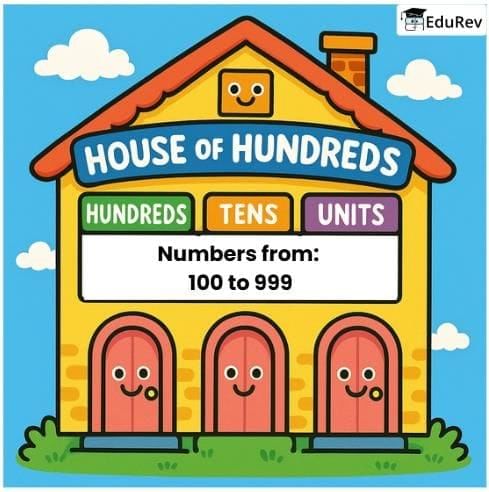
Let’s Begin the Toffee Tale
On a bright, sunny day at the busy carnival, Ajit, Tom, and Jojo came across a stall filled with yummy toffees. Jojo quickly picked up two toffees, sparking a fun guessing game among the friends.
- To count all the toffees, they first grouped them in tens: 10, 20, 30, …, 100, 110, 120, …, 190, 200, 210, …, 290
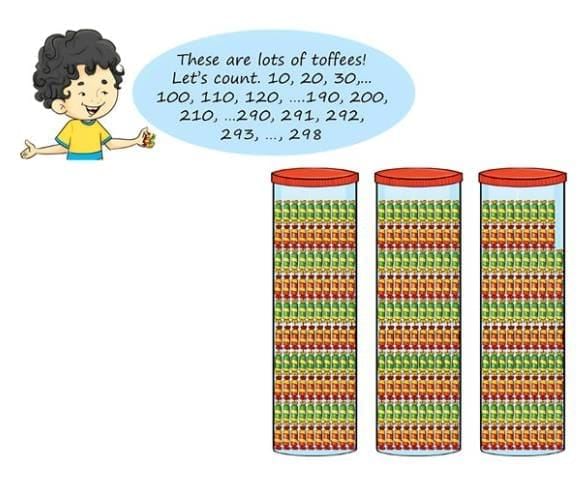
- Then they counted the last few one by one: 291, 292, 293, …, 298
- Joy held two extra toffees in his hand.How many toffees did they have altogether?
- They counted 298 in the boxes.
298 + 1 = 299
299 + 1 = 300
“300 toffees!” Joy cheered, and the friends celebrated reaching the magical number.
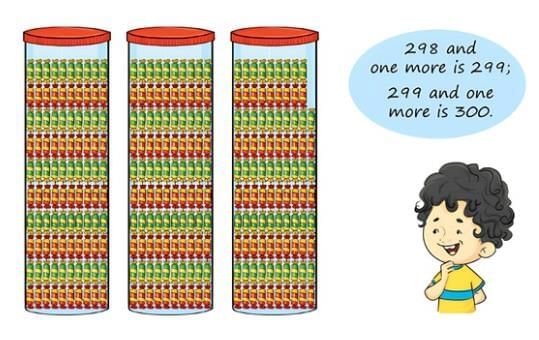
Question: Joy is hopping on the tiles at the fair. Can you guess the missing numbers below:
Have you tried guessing the numbers yet?
If not, that's okay!
The missing numbers have been given below for you:

Writing Number Sentences
To help children in developing a method for counting accurately, we can use matchsticks to visualise numbers. For instance, we can create large numbers using matchsticks or any other common materials found at home and bring them to school.
- Consider two large bundles of matchsticks. Each large bundle contains 10 smaller bundles, and each of these smaller bundles has 10 matchsticks.
- To calculate how many matchsticks are in one large bundle, we multiply: 10 (small bundles) x 10 (matchsticks in each small bundle) = 100 matchsticks in one large bundle.
- Since we have two large bundles, we multiply 100 (matchsticks in one large bundle) x 2 (large bundles) = 200 matchsticks in total from the large bundles.
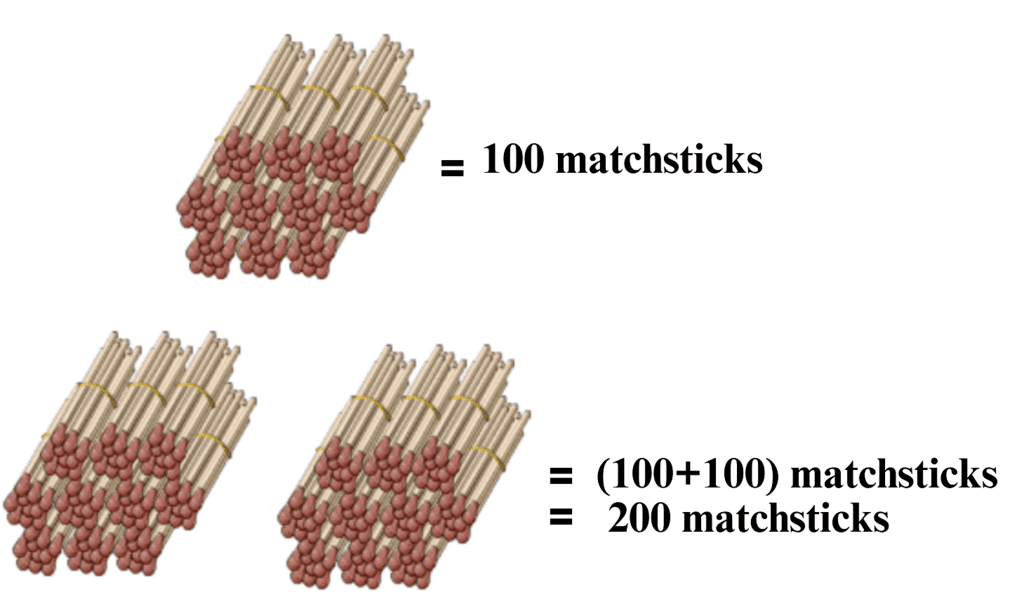
- Now, we have 3 small bundles left over along with 5 extra matchsticks.
- Each of these small bundles has 10 matchsticks, so we multiply: 3 (extra small bundles) x 10 (matchsticks in each small bundle) = 30 matchsticks from the extra small bundles.
- Adding the 5 extra matchsticks gives us 30 + 5 = 35 matchsticks.
- Therefore, in total, we have 200 matchsticks from the large bundles and 35 matchsticks from the small bundles and extra matchsticks, resulting in a total of 235 matchsticks.

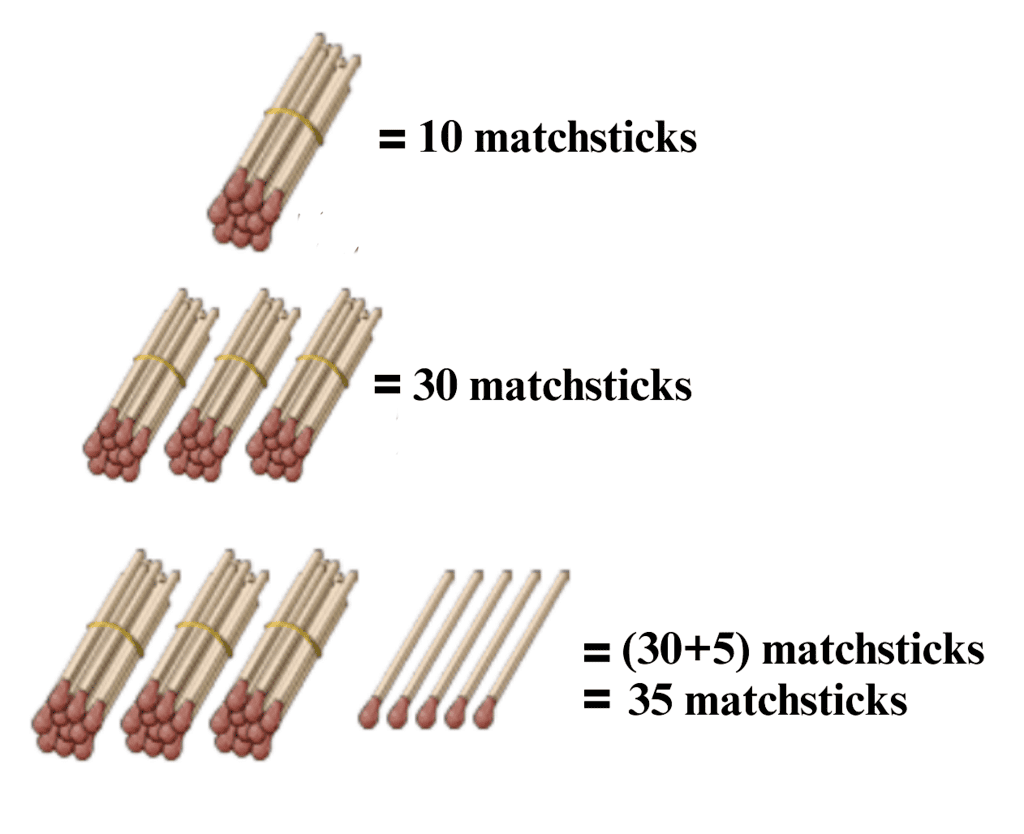
We can express the number 235 in the following ways:
- 200 and 35 more (200 + 35)
- 15 less than 250 (250 - 15)
Number Fun: Up and Down We Go!
Once upon a time, there were five friends named Jack, Lily, Ben, Mia, and Sam. They were all going on a camping trip together.
- Jack brought 5 apples for everyone to share. He gave one apple to Lily, so they had 5 apples in total. Adding 1 made the number of apples bigger.

- Meanwhile, Ben had 10 marshmallows to roast over the campfire. But Sam accidentally dropped 2 into the fire, leaving them with only 8 marshmallows. Taking away 2 made the number of marshmallows smaller.

By adding more or taking some away, the number of items they had changed during their camping adventure! Now, let's explore numbers! We'll learn how to increase or decrease them.
Increasing and Decreasing Numbers
- 285 – increase the number by one
Sol: To make the number bigger, we add one: 285 + 1. This gives us 286. - 147 – increase the number by ten
Sol: To increase the number, we add ten: 147 + 10. This results in 157. - 367 – decrease the number by 2
Sol: To make the number a bit smaller, we take away 2: 367 - 2. This gives us 365. - 289 – decrease the number by 10
Sol: To reduce the number, we take away 10: 289 - 10. This results in 279. - 290 – increase the number by 20
Sol: To make the number bigger, we add 20: 290 + 20. This gives us 310.
Now, let's compare some numbers using the signs (> or <) to="" see="" which="" is="" greater="" or="">
- 199 < 221
- 285 > 275
Yay! You've learnt how to make numbers bigger and smaller. Well done!

Counting the Number of Letters in Number Names
Counting the letters in number names is an enjoyable way to practise counting. Here’s how you can do it:
- Write Down the Number: Begin by writing the number you want to count the letters for. For example, let’s use the number "Eleven."
- Spell Out the Number: Write the number in words. "Eleven" is spelled E-L-E-V-E-N.
- Count the Letters: Count each letter in the word. "Eleven" has six letters: E-L-E-V-E-N.
- Repeat for Other Numbers: You can do this for other numbers too. For instance, "three" has five letters (T-H-R-E-E), "seven" has five letters (S-E-V-E-N), and "twenty" has six letters (T-W-E-N-T-Y).
Magical Count: Write down any number name. Count the letters in that name and then write down the new number name. Keep repeating.
Writing Numbers in Sentences
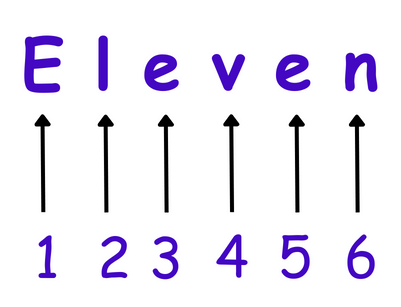
- When we count or discuss numbers, we use special words known as number names.
- These help us express numbers in words rather than just digits. Let’s explore how to write number names for three-digit numbers.
- Three-digit numbers consist of three digits. We read them from left to right, just like reading words in a book.
- The number 123 contains three digits: 1, 2, and 3. Each digit has its own place: hundreds, tens, and ones.
- To write three-digit numbers in words, we start by stating how many hundreds, then how many tens, and finally how many ones. For example: The number 123 is written as "one hundred twenty-three."
- We say (i) "one hundred" for the hundreds place , (ii) "twenty" for the tens place , and (iii) "three" for the ones place.
Let’s look at some examples of three-digit numbers:
- 256: This is read as "two hundred fifty-six."
- 378: This is read as "three hundred seventy-eight."
- 429: This is read as "four hundred twenty-nine."
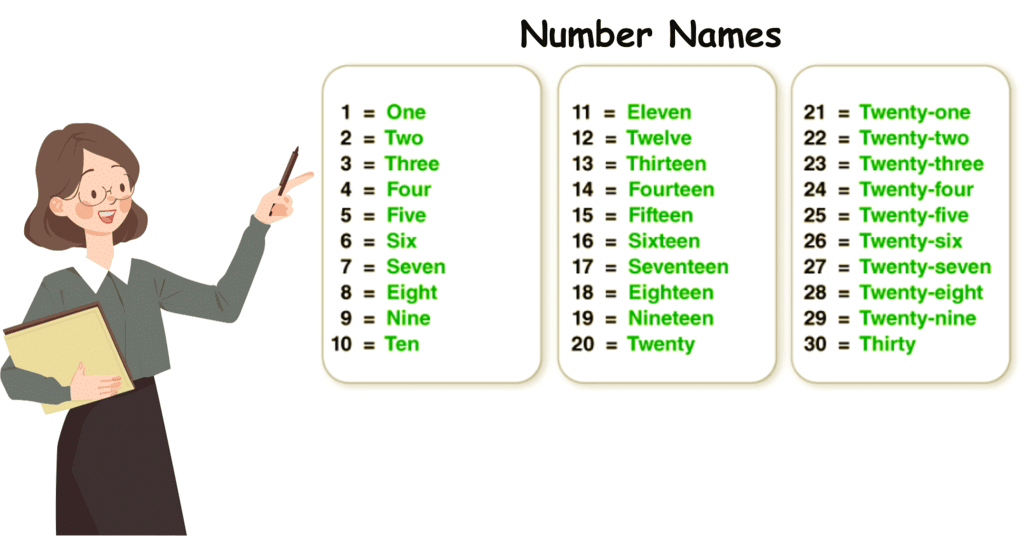
Counting the Letters
- In the colorful land of Numerica, there were three best friends: Two-hundred and Thirteen, Three Hundred and Sixty Seven, and One Hundred and Ten. They wanted to know whose name was the longest, so they decided to count the letters in their names

- They gathered around a magical counting tree, where each leaf had a letter written on it. (i) Two-hundred and Thirteen suggested they count the letters in their names. (ii)Three Hundred and Sixty Seven suggested they take turns counting each other's letters to make sure they didn't miss any.
- They started with Number Two-hundred and Thirteen and counted 21 letters.

- Then, they counted 23 letters in Number Three hundred and Sixty Seven.

- Finally, they counted 16 letters in Number One Hundred and Ten.

- They discovered that Number Three hundred and Sixty Seven had the longest name with 25 letters.
They agreed that each of their names was unique and special. They were happy to learn how to count the letters in their names.

Counting Numbers on a Number Line
Number Line
A number line is a helpful way to show numbers in order from the smallest to the largest. It helps us see how numbers relate to one another. The number line includes positive numbers, negative numbers, and zero.
Picture yourself at one end of the number line. As you move along it, you’ll notice the numbers increase. If you go the opposite way, the numbers decrease.


Counting on a number line is similar to taking steps. For instance, if we count from 100 to 110:
- Start at 100
- Step to 101
- Then to 102
- Next to 103
- Finally, reach 110
The number line also includes zero, an important number that acts as a middle point. To the left of zero, we have negative numbers which are less than zero, such as:
- -1
- -2
- -3
So, number lines help us understand how numbers are arranged and how we can move between them. Grasping both positive and negative numbers on the number line is essential for understanding basic mathematical ideas.
Understanding Place Value
- In maths, every number consists of different parts known as digits.
- Each digit has a specific value depending on its position in the number, which we call place value.
For example, consider the number 786. In this number: 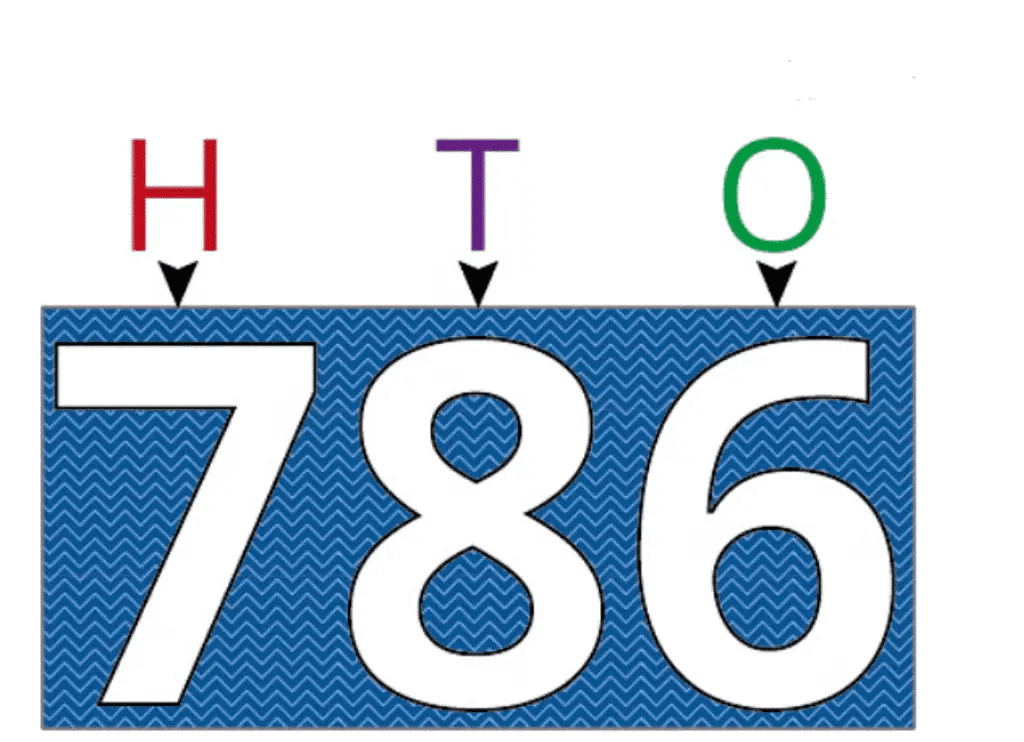
- The digit 7 is in the hundreds place, giving it a value of 700.
- The digit 8 is in the tens place, making its value 80.
- The digit 6 is in the ones place, so its value is just 6.
Together, these values add up: 700 (from 7 hundreds) + 80 (from 8 tens) + 6 (from 6 ones) equals 786. Understanding place value helps us grasp the value of larger numbers.
Now let's take the number 24 as an example.
- It has two digits.
- The digit 4 represents four single items, and it's placed in the ones position.
- The digit 2 in the tens place represents two bundles of ten items each, which makes twenty.
- So, when we combine the value of 20 with the value of 4, we get the number 24.
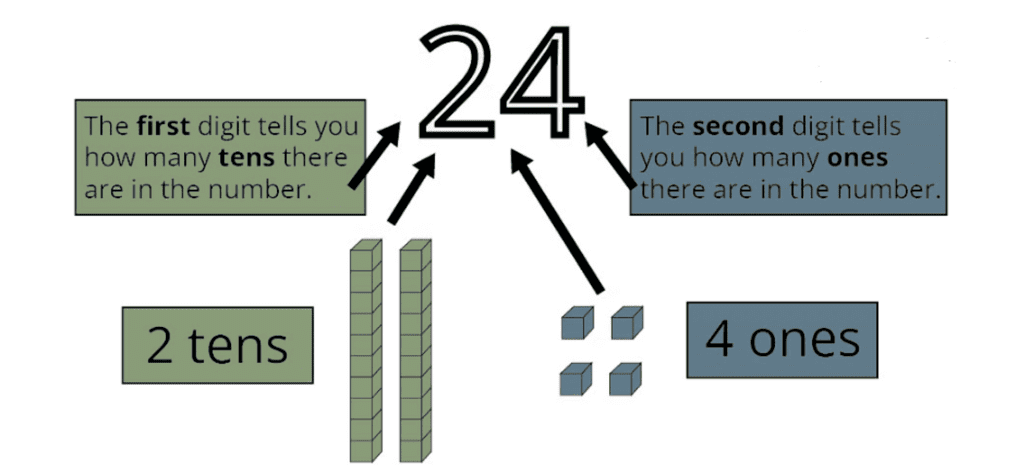
Comparing Numbers
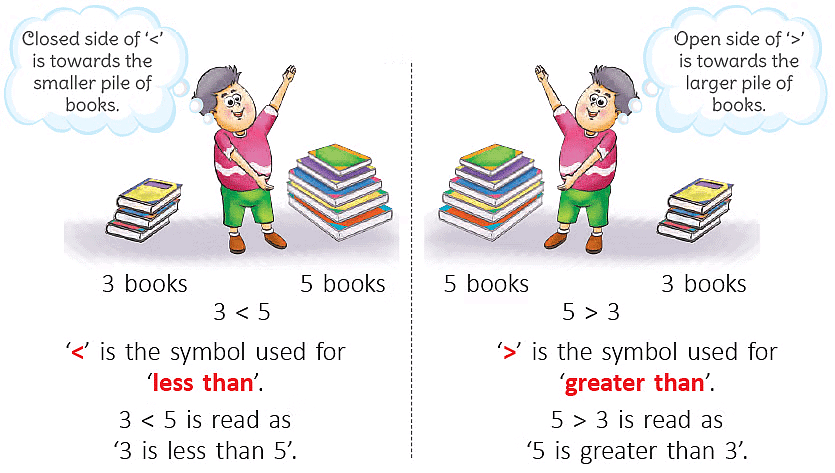
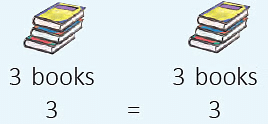 '=' is the symbol used for 'equal to'.
'=' is the symbol used for 'equal to'.
- 3 = 3 is read as '3 is equal to 3'.
- Look at the numbers from 11 to 20 in order.
 The number 13 is to the left of 14. So, 13 < 14. The number 14 is to the right of 13. So, 14 > 13. Every number is equal to itself. 14 = 14, 15 = 15, 16 = 16, etc.
The number 13 is to the left of 14. So, 13 < 14. The number 14 is to the right of 13. So, 14 > 13. Every number is equal to itself. 14 = 14, 15 = 15, 16 = 16, etc.
Note:
- When comparing two numbers, help children focus on the quantities that the numbers represent.
- Use Dienes block representation to show that 1 H is more than 1 T and 1 O. Similarly, 1 T is more than 1 O.
Comparing 3-digit Numbers
- To compare numbers, we check their hundreds, tens, and ones places.
- If the hundreds places are the same, we move to the tens. If those are equal, we then look at the ones place.
- Encourage children to think about what the numbers actually represent.
- Use Dienes blocks to illustrate that 1 H is greater than 1 T and 1 O, and that 1 T is greater than 1 O.
- Examples: (i) 329 and 392: Both have three hundreds, but 329 has 2 tens while 392 has 9. Thus, 392 is greater. (ii) 235 and 523: 235 has 2 hundreds and 3 tens, while 523 has 5 hundreds. So, 523 is greater. (iii) 157 and 153: 157 has 7 ones, while 153 has 3. Therefore, 157 is greater. (iv) 432 and 423: Both have four hundreds, but 432 has 3 tens compared to 2 in 423. Thus, 432 is greater.
Ascending and Descending Orders
When it comes to numbers, putting them in order from the largest to the smallest is called descending order or decreasing order. On the other hand, putting them in order from the smallest to the largest is called ascending order or increasing order.
- Moving from the largest number to the smallest is known as descending order.
- Moving from the smallest number to the largest is known as ascending order.
For instance, the numbers 2, 4, 5, 8, and 9 are arranged in ascending order, while 9, 8, 5, 4, and 2 are in descending order.
To compare numbers, we use the symbols > (greater than) and < (less= than)="" to="" indicate="" their="" relationships.="" for="">
- 199 < 201, which means 199 is less than 201.
- 285 > 275, indicating that 285 is greater than 275.
Now, let’s compare the following numbers and use the symbols > and <>
- 185 < 211.
- 295 > 265.
Consider these examples:
- 432 is > 423 because both have four hundreds, but 432 has 3 tens while 423 has 2 tens.
- 329 is < 392 because both have three hundreds, but 329 has 2 tens while 392 has 9 tens.
- 110 is > 11 because 110 has 1 hundred while 11 has no hundreds (zero hundreds).

Use of > or < in Forward and Backward Counting
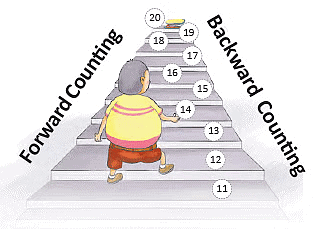
- Jiya starts climbing the stairs from stair number 11. She has to reach stair number 20 to pick up her pencil pouch that she dropped there.
- As she climbs up, she counts upwards as 11, 12, 13, 14, 15, 16, 17, 18, 19, and 20. On her way down with the pencil pouch, she counts backwards as 20, 19, 18, 17, 16, 15, 14, 13, 12, and 11.
- 11 < 12 < 13 < 14 < 15 < 16 < 17 < 18 < 19 < 20 shows the ascending order of numbers from 11 to 20. 20 > 19 > 18 > 17 > 16 > 15 > 14 > 13 > 12 > 11 shows the descending order from 20 to 11.
Numbers get “bigger/greater” when counting forward and “smaller/lesser” when counting backward.
Forming 3-Digit Numbers
Sometimes, we are given certain digits and asked to make the smallest and greatest 3-digit numbers without using any digit more than once.
Forming the Greatest Number
- To create the greatest number, arrange the digits in descending order, starting from the hundreds place.
- Select the largest digit for the hundreds place, the next largest for the tens place, and the smallest for the ones place.
Forming the Smallest Number
- To create the smallest number, arrange the digits in ascending order, starting from the hundreds place.
- Choose the smallest non-zero digit for the hundreds place, the next smallest for the tens place, and the largest for the ones place.
Examples:
- Digits: 3, 7, 2
Greatest 3-digit Number: 732 (Descending order: 7 > 3 > 2)
Smallest 3-digit Number: 237 (Ascending order: 2 < 3=""><> - Digits: 5, 6, 2
Greatest Number: 652 (Descending order: 6 > 5 > 2)
Smallest Number: 256 (Ascending order: 2 < 5=""><>
Let's Practice!
Question 1: Fill these:

 View Answer
View Answer 
Answer: 
Question 2: Write down any number name. Count the number of letters in that number name and write the name of that new number down. Keep repeating — what happens?
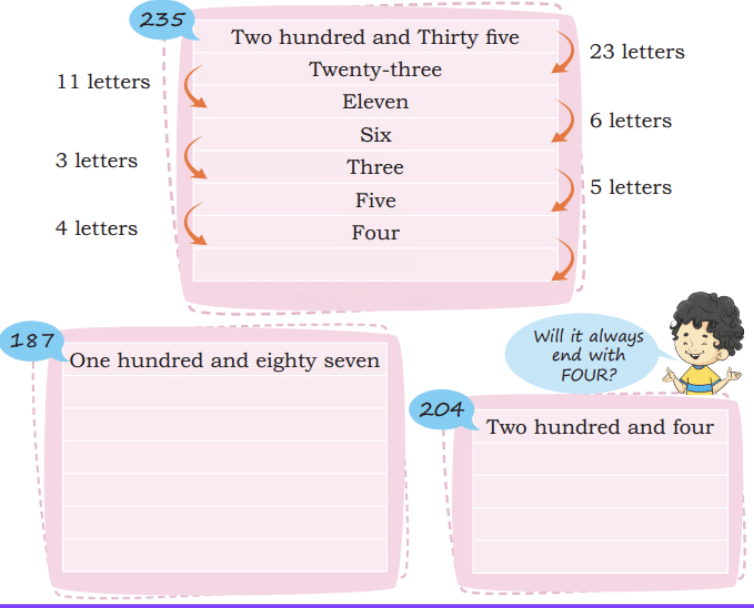
 View Answer
View Answer 
Answer: 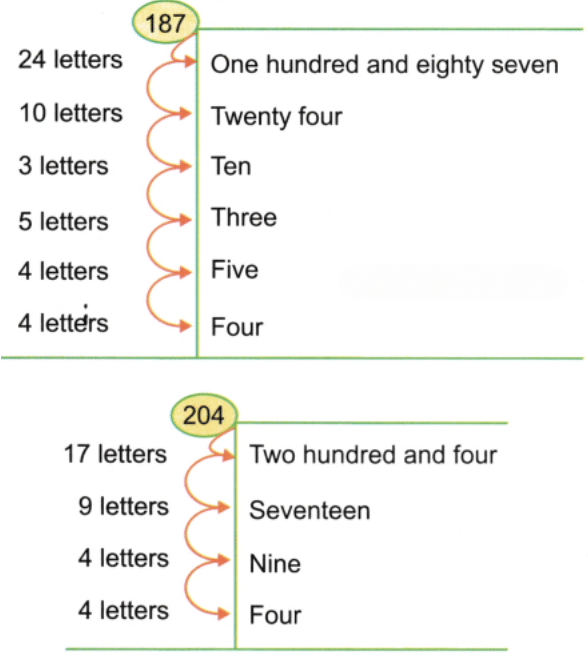
|
26 videos|180 docs|28 tests
|
FAQs on House of Hundreds - I Chapter Notes - Mathematics for Class 3 (Maths Mela)
| 1. What are some effective strategies for counting toffees in a class activity? |  |
| 2. How can understanding place value help in comparing numbers? |  |
| 3. What is a number sentence and how can it be used in math learning? |  |
| 4. How can students practice counting letters in number names effectively? |  |
| 5. What activities can help students understand comparing 3-digit numbers better? |  |






















